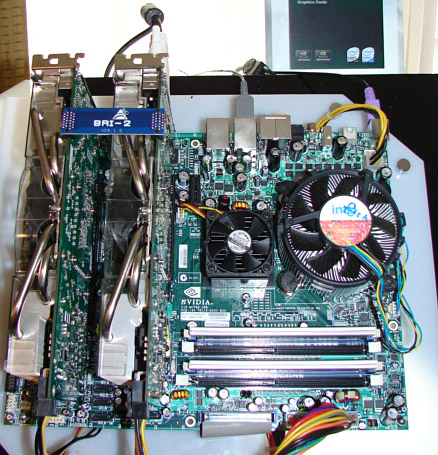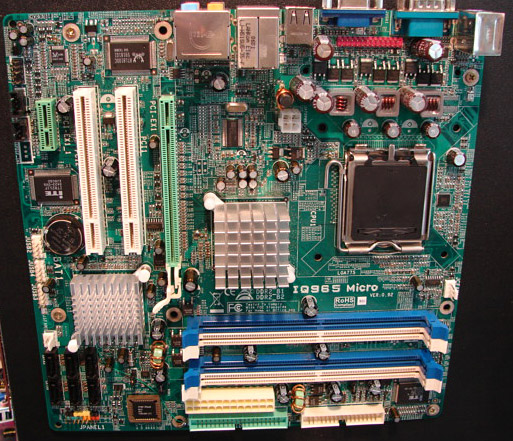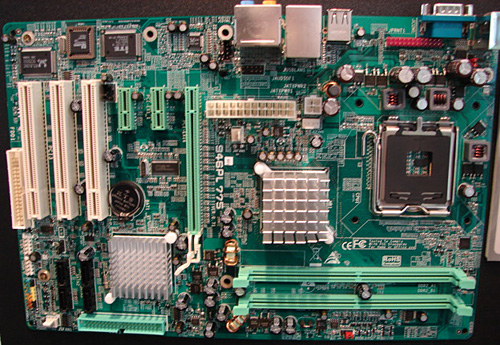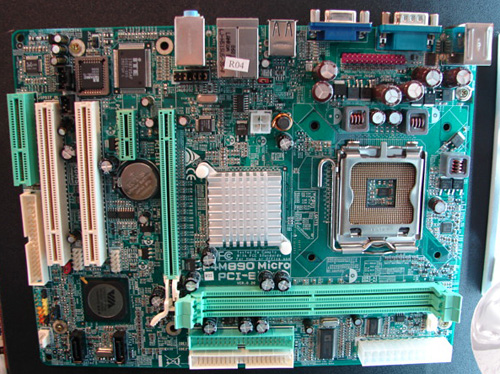Computex 2006: Abit is back, Biostar expands, and Thermaltake dazzles
by Gary Key on June 10, 2006 4:00 AM EST- Posted in
- Trade Shows

We spoke at length with Tomasz Swatowski, Marketing Assistant Manager; Kenny Tseng, VGA Marketing; and Jason Li, Marketing Specialist during our visit with Biostar. Biostar has been in existence since 1986 and has a long history of providing good products at very competitive price points. They have recently branched into the video card market with a wide array of offerings, and they continue to offer new SFF systems.
Their current focus is on expanding their business by offering higher quality products targeted towards the gamer and enthusiast markets. This includes top of the line NVIDIA based video cards along with higher end motherboards in the performance sector with their TForce series of products. Our recent review of their TForce 590 SLI Deluxe board certainly impressed us with the strides they have made recently in addressing this growing market segment.
Biostar: Intel Motherboards
While Biostar offers a wide variety of AMD based products, their focus at Computex was clearly on the Core 2 Duo boards.

Biostar was one of several manufacturers demonstrating the reference NVIDIA SLI 590 board with full support for Core 2 Duo.

One of the more interesting boards we saw was the Biostar G965 Micro 775 board featuring the Intel 965G (X3000 integrated graphics) and ICH8 chipsets. Although Intel will not be ramping up the 965G chipset production until August, it appears that Biostar is one of the first to have working samples available for display.

Biostar's budget minded Intel chipset board is the 946PL 775 featuring the Intel 946PL and ICH7 chipsets.

Biostar is offering two different VIA based boards that support Core 2 Duo with the P4M890-MY PCI-E board sporting the VIA P4M890 (IGP) Northbridge and VT8237R+ Southbridge. Expect this board and the more performance oriented PT890 775 (for VIA) to be available around the US $45~$55 price points.










27 Comments
View All Comments
Operandi - Sunday, June 11, 2006 - link
Lian Li and SilverStone need companies like Thermaltake to make ugly ass cases to make theirs look good. ;)Griswold - Saturday, June 10, 2006 - link
Or the all-time classic:Optimus Prime called, he wants his chest armor back!
Lonyo - Saturday, June 10, 2006 - link
Putting passive cooling on their "max" motherboard. It makes me sad.vailr - Saturday, June 10, 2006 - link
Only one PCI slot on Abit's "Top of the Line" board? No thanks. Would need at least 2, or preferably 3 PCI slots.And regarding the passive/heatpipe chipset cooling: these won't work with some of
the Lian-Li mid-tower cases where the motherboard is oriented "upside-down".
Chernobyl68 - Saturday, June 10, 2006 - link
That was my first thought when I started seeing all of the passive cooling solutions out there...how would it work with the Lian-Li case I plan to buy? do I need to reconsider my options? I thought all I was waiting on was an acceptable motherboard to be released before I make my new system but I may be waiting a bit longer.Chern
Gary Key - Saturday, June 10, 2006 - link
We discussed this at length with Abit, too late to change now but we told them there would be a backlash. Also, if you run CrossFire or SLI, that single PCI slot is gone.
LoneWolf15 - Saturday, June 10, 2006 - link
Major case of "Aim gun at foot, pull trigger".
Unless Abit is willing to come up with some high quality PCIe peripherals to match, their high-end single-PCI slot boards are worthless, and releasing them will be a major monetary loss. With Crossfire/SLI, this means no Creative X-Fi (or insert other better-than-onboard-sound-card here), and limited choice of any other peripherals.
Universally stupid.
JarredWalton - Saturday, June 10, 2006 - link
The only major loss is sound card support, as you can currently get Theater 550 TV Tuners in PCIe format. I'm personally finding onboard audio sufficient for my needs, especially with the latest HDA solutions. X-Fi sounds better and cleaner, but it's not something you really notice unless you have really nice speakers/headphones.It's sort of like integrated NICs - is there anyone out there that really cares about the difference between 700 Mbit vs. 950 Mbit GbE performance? The only time I touch those speeds is when doing theoretical tests; HDD speeds are the limit otherwise, and gaming? Don't make me laugh: games don't even stress a 10 Mbit Ethernet connection in most instances, and certainly don't need more than 100 Mbit.
Anyway, my point is that integrated audio is fast nearing the point where few people worry about add-in sound cards. Get some digital speakers and use the S/PDIF connections on nice motherboards, and I'd love to see some people do a "blind" listening test. I'm sort of curious about what percentage of our readers still use add-in sound cards - I would be surprised if it's more than 10%.
Odeen - Tuesday, June 13, 2006 - link
There are a few problems with onboard audio. The sound quality is one of them. The second problem is the PERFORMANCE hit and the 3d sound rendering features available.Basically, onboard audio (and outboard audio processors without hardware DS3D and EAX support can emulate EAX, but not perfectly. EAX 4.0 is a no-go at all. And this emulation is tantamount to doing software 3D rendering - it's very slow, especially when dozens of sounds need to be located in 3D space and processed.
Any gamer owes it to himself to use a sound card capable of 3D sound processing, or they're cheating themselves out of frame rates.
BPB - Saturday, June 10, 2006 - link
Did they really think that people running Crossfire setups wouldn't at least want better-than-onboard sound? That alone is one PCI slot. The onboard sound looks good, but is it that good?